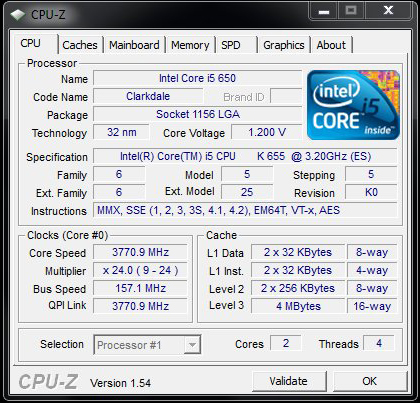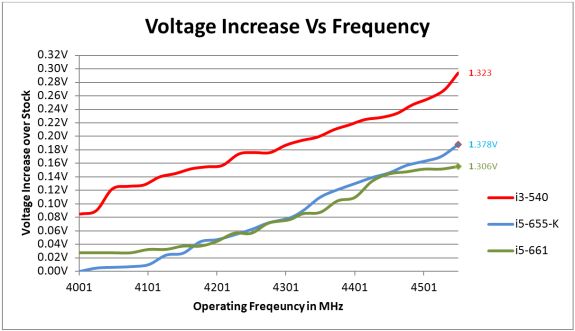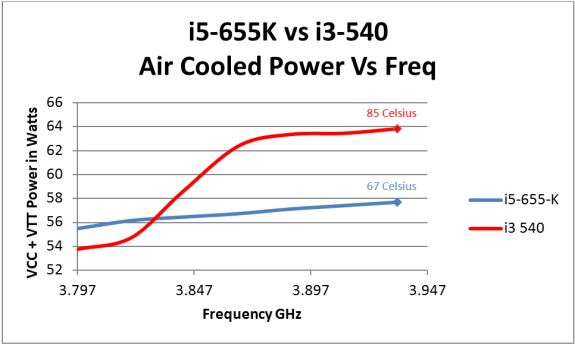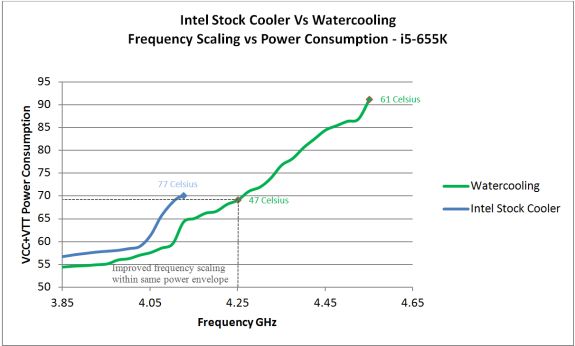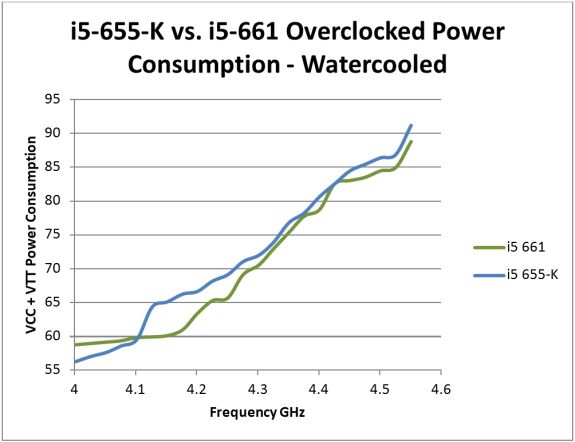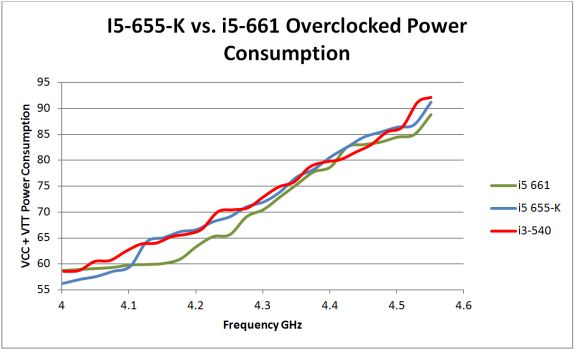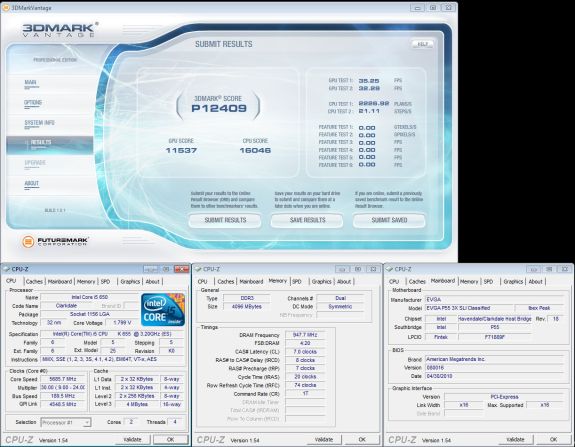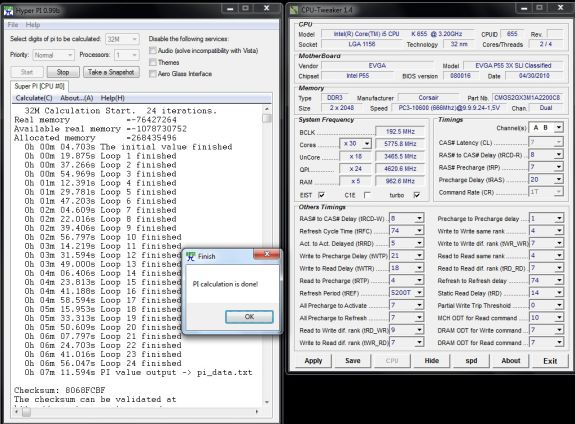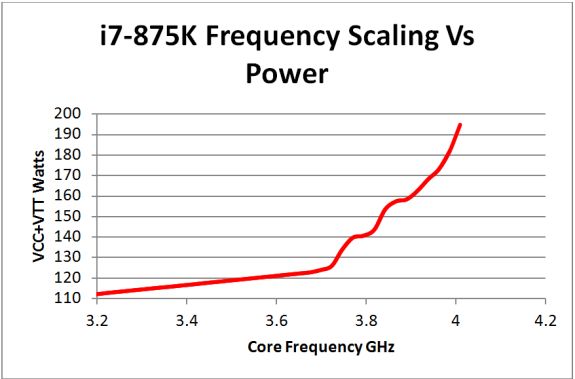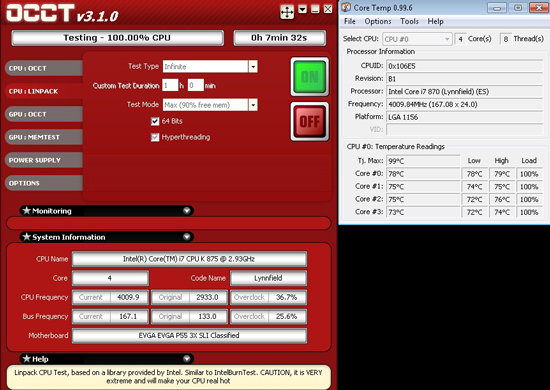
Original Link: https://www.anandtech.com/show/3742/intels-core-i5655k-core-i7875k-overclocked-and-analysed-
Intel’s Core i5-655K & Core i7-875K: Overclocked and Analyzed
by Rajinder Gill on May 28, 2010 5:00 AM ESTWhen it comes to Intel processors, the word “unlocked” is not synonymous with low-priced mainstream products - it’s a feature normally reserved for flagship ‘Extreme Edition’ CPUs that bear higher price tags. Things are set to change today because Intel is launching the “unlocked” K series of processors to fit into the existing Lynnfield and Clarkdale line-up:
| Processor |
Core (GHz) |
Unlocked | Turbo Frequency (GHz) | Max Mem Clock | Cores / Threads | L3 Cache |
TDP |
Price |
| Intel Core i7-980X | 3.33 | Cores, DDR3, Power | Up to 3.60 |
3 Channels 1333MHz |
6 / 12 | 12MB | 130W | $999 |
| Intel Core i7-870 | 2.93 | DDR3, Power | Up to 3.60 |
2 Channels 1333MHz |
4 / 8 | 8MB | 95W | $562 |
| Intel Core i7-875K | 2.93 | Cores, DDR3, Power | Up to 3.60 |
2 Channels 1333MHz |
4 / 8 | 8MB | 95W | $342 |
| Intel Core i5-655K | 3.20 | Cores, DDR3, Power | Up to 3.46 |
2 Channels 1333MHz |
2 / 4 | 4MB | 73W | $216 |
| Intel Core i5-650 | 3.20 | DDR3 | Up to 3.46 |
2 Channels 1333MHz |
2 / 4 | 4MB | 73W | $176 |
| Intel Core i3-540 | 3.06 | DDR3 | N/A |
2 Channels 1333MHz |
2 / 4 | 4MB | 73W | $133 |
|
Intel Core i3-530 |
2.93 | DDR3 | N/A |
2 Channels 1333MHz |
2 / 4 | 4MB | 73W | $113 |
While it is interesting that Intel is offering unlocked core multipliers on Lynnfield and Clarkdale, it’s more interesting that the models being introduced are not the most expensive in their respective families. Especially considering that the i7-875K’s stock speeds are identical to the i7-870 while costing less. At $349, it's only a stone's throw away from AMD's 1090T, while you've got the i7-860 coming in cheaper than both. All of these processors can be compared to one another in Bench here and here.
Overclockers will sit up and take note at the prospects of increased flexibility and the potential of alleviating bottlenecks caused by insufficient bus margins on cheaper processors. We've all had CPUs that seem to have additonal headroom for frequency scaling, but are held back because the highest available core multiplier ratio is too low. We increase reference clock freqeuncies, only to find that some of the related busses aren't completely stable and as a result no choice but to fall back or relax key performance registers which defeats the purpose of performance related overclocking. That's one of the areas where the K-series might help. Another key factor that makes unlocked processors attractive is that they open the doors to easy overclocking for users that like to keep things simple. With unlocked multipliers we can overclock the CPU without having to fiddle around with memory ratios or memory timings, leaving those settings static.
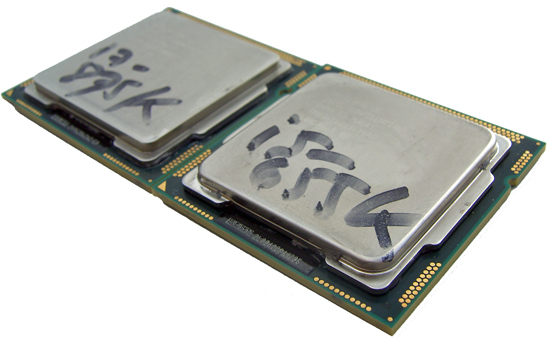
As there are no under-hood changes to the substrates themselves, there’s not a whole lot of benchmarking for us to do in this review. We’ve already compared the performance of similarly clocked non K-series Lynnfield and Clarkdale processors in our platform launch articles and also have a range of comaprisons in Anandtech Bench. Our focus in this write-up is to look at how the i5-655K and i7-875K fit from an overclocking perspective against both their cheaper and more expensive counterparts.
Be for-warned that this isn’t a typical launch piece; it’s full of talk about voltages and harps on about overclocking in a way that will send many readers to sleep. If that isn’t a big enough deterrent, then read on…
Testbed Setup
|
Testbed Setup Overclocking / Benchmark Testbed |
|
|
Processors Used: |
Intel i7-875K ES CPU, 2.93GHz, 8 Threads, 8MB Cache Intel i5-750 Retail, 2.66GHz, 4 Threads, 8MB Cache Intel i5-655K ES CPU, 3.20GHz, 2 Cores 4 Threads, 4MB Cache Intel i5-661 ES CPU, 3.33GHz, 2 Cores 4 Threads, 4MB Cache Intel i3-540 Retail, 3.06GHz, 2 Cores 4 Threads, 4MB Cache |
| CPU Voltage | Various |
| Cooling | Intel air cooler, Heatkiller 3.0 waterblock, ThermoChill PA120.2 radiator and DDC Ultra pump (with Petra top). 1/2" ID tubing for watercooling. |
| Power Supply | Corsair HX950 |
| Memory |
Corsair Dominator GT 8-8-8-24 2200MHz 4GB kit (X2 for 8GB) |
| Memory Settings | 8-8-8-24 - 1T |
| Video Cards | MSI 275 Lightning (stock clocks) |
| Video Drivers | nVidia 195.62 WHQL |
| Hard Drive |
Western Digital 7200RPM 1TB SATA 3/Gbps 32MB OCZ Vertex 120GB SSD |
| Optical Drives | Plextor PX-B900A, Toshiba SD-H802A |
| Case |
Open Test Bed - Dimastech Benching Station Lian-Li V2110 |
| Operating System | Windows 7 64-bit |
| . | |
EVGA’s Classified motherboard was used for all of the overclocking and power consumption plots. We used a DC clamp meter directly on the EPS 12V power line to monitor current draw to VCC and VTT. Fortunately, we happen to know the approximate efficiency curve of the Volterra VRM so have taken the time to account for the switching losses in all figures shown.
Corsair’s Dominator GT 2200MHz kit was used at CAS 8-8-8-24 timings from DDR-3 1333MHz ~ DDR3 1820MHz. Not exactly tight for this kit, but representative of the memory timings many users will run using affordable memory kits on these processors (given the nature of the Clarkdale IMC).
For comparative purposes, all components used were exactly the same throughout our testing. All memory timings and bus frequencies were matched up as needed (unless specified otherwise).
Clarkdale i5-655K Overclocking
We’ll start off with the basics. First off, the maximum overclock using stock voltages:
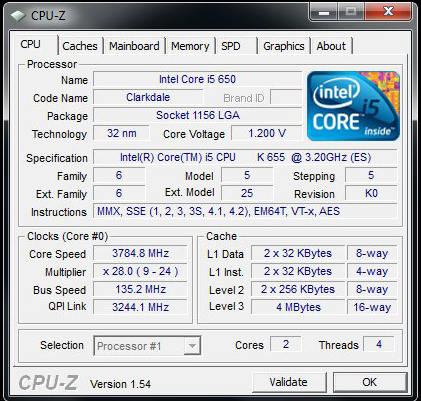
Next up, maximum stable overclocks:
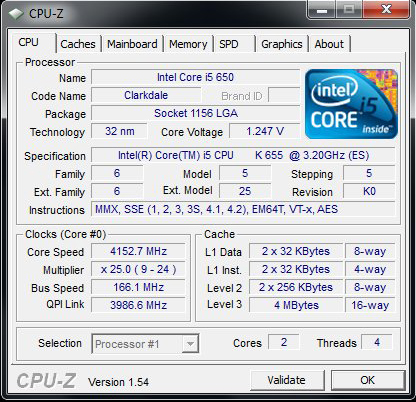
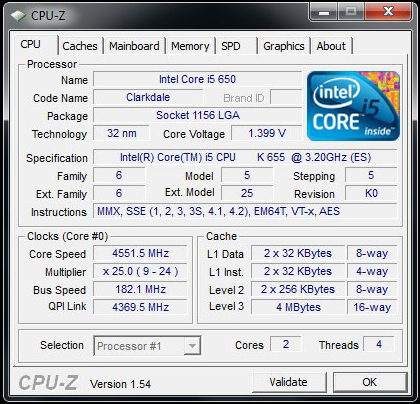
We’re often criticized for being a little brief and thin on overclocking results for our processor launch articles so we’re going to break things down a little further today and take a look at sensible operating points and compare the power curves of different processors.
VID, VCC & Relative Frequency Scaling
First up, let’s take a look at the stock voltages programmed by Intel (VID) for each processor on test today, and the required voltage under full Linpack load at stock frequency and 4.55GHz.
Do note, that actual load voltages will vary from board to board depending upon loadline resistance, Voffset and Vdroop. For the uninitiated, Voffset is difference between the applied voltage and the actual idle state voltage, while Vdroop is the level of voltage sag between idle and full load processor states. These safety margins are necessary to ensure that the real time voltage level (VCC), does not breach the applied VID for extensive periods or by excessive levels (acceptable overshoot margins are stipulated in the Intel white papers). Further explanation of these design principals is provided here.
| Processor | Stock Frequency | Turbo Mode | Stock VID | Stock VCC (Load) | VCC @ ~4.55GHz (Load)* |
| i3-540 | 3.06GHz | N/A | 1.0500V | 1.029V | 1.323V |
| i5-655K | 3.20GHz | 3.46GHz | 1.2125V | 1.190V | 1.378V |
| i5-661 | 3.33GHz | 3.6GHz | 1.1625V | 1.143V | 1.306V |
*Overclocked voltage requirements using water-cooling.
At first glance, the i5-661 stands out for having a relatively low stock VID in relation to its maximum single-threaded Turbo mode speed of 3.6GHz. That’s 160MHz higher than the i5-655K with a small reduction in voltage. Not only that, but it manages to reach 4.55GHz using the lowest VCC of these three test samples.
Here’s a graphical representation of how each processor scales frequency versus voltage, normalized to each part's stock VCC:
Of course, this is but a mere portion of the story, what we’re interested in is the power consumption of each processor at equivalent frequencies and how that has an impact on frequency scaling given various forms of cooling.
Here's the idle/full load power consumption figures at stock speeds. VCC and VTT only, with VRM switching efficiency factored out:
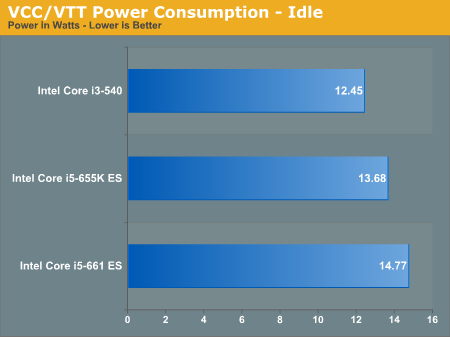
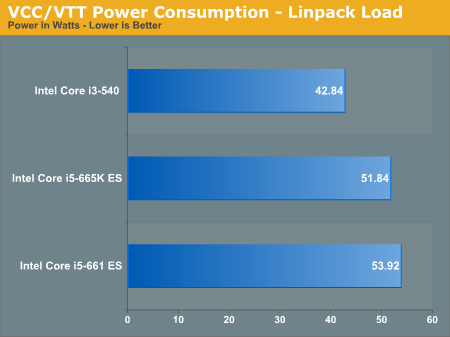
Now that we've got these figures as a reference point. We can start looking at how each processor reacts to over-frequency conditions and how this affects factors such as heat and stability.
The following graph shows processor power scaling versus frequency, using Linpack to load the cores – highlighting the maximum Stock VID overclock and the maximum overall overclock using the Intel heatsink:
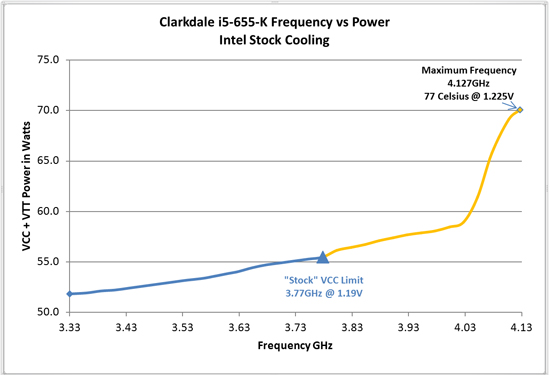
Using the BCLK method of overclocking (increasing the frequency of every associated bus), the power consumption ramp between 3.33GHz and 3.77 GHz is a mere 4 Watts at stock VID on our i5-655K – that’s why overclocking at stock voltages is wise if you’re working within the confines of stock cooling or concerned for processor longevity. In fact, only a small change in voltage is required to reach the 4GHz mark, coming in at a very sensible 7 Watt rise over stock power draw.
Over 4GHz, we see a sharp hike in power draw for every 20MHz increase in frequency, and by the time we get to 4.127GHz we’re tapped out on the stock Intel cooler. Increasing voltage at this point does not help, and we start seeing uncorrectable errors during Linpack. At this point, we need better cooling to extend our overclocking headroom. Before we experiment with improved cooling though, its worth taking a look at how things compare to a retail i3-540 using Intel’s stock heatsink.
Better than our i3-540 for Overclocking?
Part of the attraction generated by the allure of unlocked multiplier processors is the additional flexibility purportedly provided, allowing any manner of clock domain frequency combinations. The obvious question has to be what an unlocked multiplier set offers the Clarkdale topology? The real ticket to retaining performance on this platform is to keep QPI frequency as close as possible to processor core frequency. That’s because the memory controller is off-die and the CPU communicates with the memory controller via the QPI link (the data link between the MCP stages in the images below).
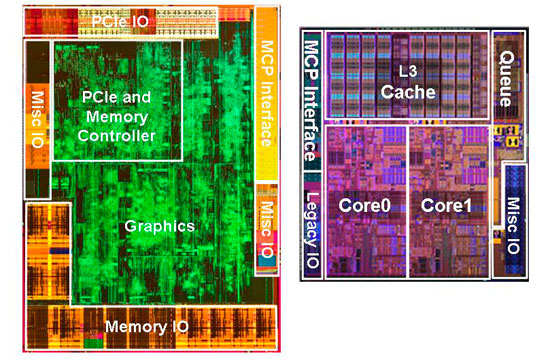
Too wide a gap between both clock domains and the CPU must hold data for longer periods of time in the associated buffer stage before it can be transferred to the next bus. As a result, setting too high a CPU multiplier with too low a reference clock (BCLK) would neglect QPI bus frequency. This is because Intel limits the range of QPI multipliers at our disposal. What we want to use is a CPU core multiplier that is the same as or one notch higher than the QPI multiplier ratio.
Another thing that becomes readily apparent with the Clarkdale topology is that memory speeds around the DDR-3 1800 mark are generally the upper limit for most processors when absolute stability is required at reasonable voltage levels. Slightly higher speeds are possible but only by sacrificing valuable memory access latency – meaning you have to either run loose memory timings or drop QPI frequency to compensate. Given the choice, we’d sacrifice a little memory bandwidth before sacrificing a lot (lowering the QPI frequency). With this in mind, all of our comparisons have been made using the highest available QPI multiplier ratio on each processor, with the actual QPI frequency closely matched:
Now that we’ve got a couple of baselines out of the way using Intel’s stock heat-sink, it’s time to peg thermals back a bit on and see how the i5-655K substrate responds to lower load temperatures:
i3-540 vs. i5-655K vs. i5-661
Next up, let’s take a look at the power scaling of the i5-665K against the more expensive albeit locked multiplier variant, the i5-661:
i5-655K Meets a Cold Snap
Our dual rotary cascade is capable of holding -108 Celsius temperatures under full load from a Clarkdale processor clocked to 5.9GHz. For the i5-655K we’re kicking-off with Vantage:
Almost 200MHz behind the i5-661 in this test and around 100MHz behind our retail i5-540. Luckily for the i5-655K, this particular benchmark is not high on most peoples' agenda for Clarkdales. The real fun zone is Super Pi 32M:
Ok, so we got a little carried away on the Clarkdale stuff. Time to give the i7-875K a look-see. After all, it’s probably the bigger story of the K-series release given it offers more overclocking features and a similar stock clock speed to the more expensive i7-870.
No beating around on this one, we started off with watercooling:
Without water-cooling, there isn’t much headroom at all - at least not on this sample. Our i7-870 ES manages 4.4GHz, pulling 201 Watts during Linpack. The 875-K is already at 193 watts, and it has barely broken 4GHz. Past 3.9GHz, we’re already looking at a 10W increase in power consumption for every 20 MHz rise in CPU frequency - let’s just say that this did not encourage us to push any further. Well, that’s not completely true because we did try it out under our cascades. Unfortunately, things are pretty bad in the sub-zero realms, too. The substrate can’t handle more than 1.35Vcore when cooled below -70 Celsius, making it a difficult chip to control and one that’s ultimately limited in headroom. The best we managed was a run of Vantage at 4.5GHz, which really isn’t worth bragging about.
Final Words: Not for Enthusiasts
This is another of those situations where we’ve had to make an eleventh-hour conference call with Intel to work out what and who these processors are aimed at. Our initial perception of this launch turned out to be wrong - because we thought we'd see some kind of additional overclocking overhead from the K-series SKUs that would make them stand out from the crowd.
Our perceptions changed when Intel told us that they will not be binning these processors in a special way or marketing them at die-hard overclockers, but instead at system builders who can utilize the unlocked core features to provide cheap pre-overclocked systems with minimal fuss. In the same vein, the K-series will allow users to purchase cheap motherboards that don’t need overly complex BIOS options as we only need control of core multiplier ratios and VCore to get a quick and easy overclock. Bearing these aspects in mind, it’s hard for us to be negative about this launch; however, we’d like to see Intel unlock more processors in the future.
Out of the two processors Intel have launched today, it's the i7-875K that hits the mark on price. Sure, it's not going to set the world on fire with overclocking records but it does present users who are in the market for an all-round cruncher with a viable alternative to the AMD 1090T and the Intel i7-860 without breaking the bank.

